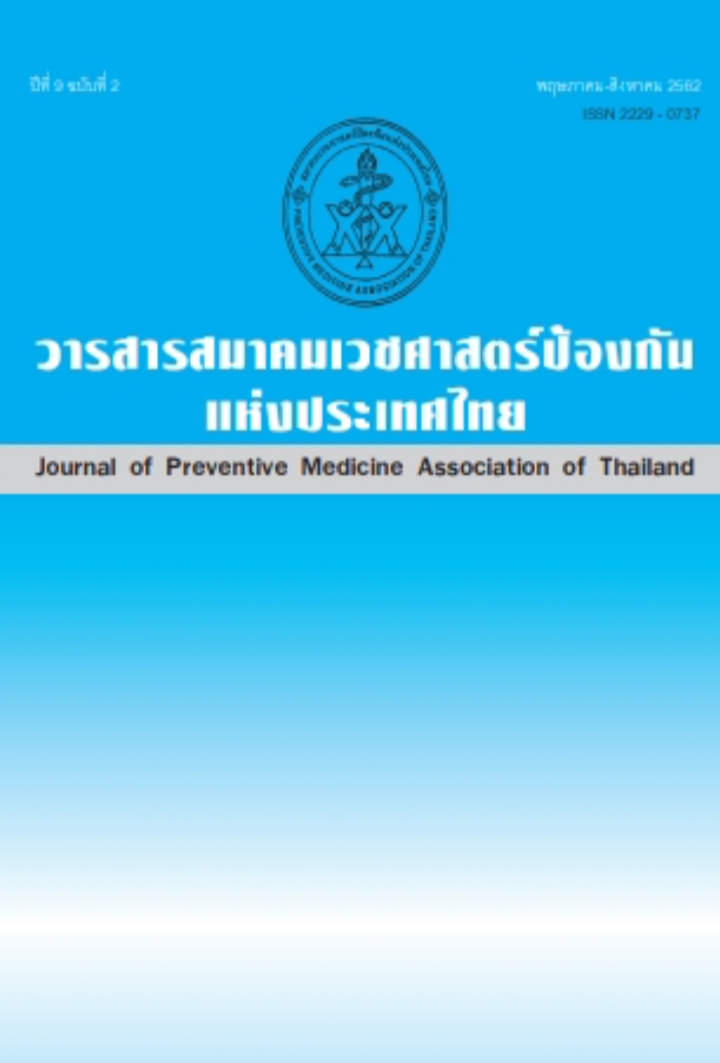Indoor Air Quality and Microbial Indoor Air Quality in Tertiary Care Hospital
Keywords:
Indoor air quality in hospital, airborne microorganism, air qualityAbstract
This descriptive study was conducted to determine indoor air quality; temperature, relative humidity, carbon dioxide, total volatile organic compound and microorganisms as bacteria and fungi in Roi Et Hospital. We collected 38 air samples in November 2018. The results found that mean of temperature was 27.00±2.37 ํc. Mean of relative humidity was 55.43±6.52 percent. Median of air velocity was 3 m/s. Median of CO2 was 429 ppm. Mean of total VOCs was 0.63±0.67 ppm. Bacterial counts were in range 30-1024 CFU/m3 and median bacterial count was 136 CFU/m3. Fungal counts were in range 30-640 CFU/m3 and median was 210 CFU/m3. These results compared with the recommendation and standard values for indoor air quality showed that 13.15 percent of the samples was in range for acceptable temperature; 76.32 percent for acceptable relative humidity; 39.47 percent for acceptable air movement; 97.37 percent for acceptable CO2; total 100 percent for acceptable volatile organic compounds; 81.58 percent for acceptable total bacterial counts and 89.47 percent for acceptable total fungal counts. The area that not passed the recommendation level was an indication of poor ventilation or an unsanitary condition and needed remedial action.
References
2. วีรานุช หลาง. จุลชีววิทยาสิ่งแวดล้อม. พิมพ์ครั้งที่ 2. กรุงเทพฯ: โรงพิมพ์มหาวิทยาลัยเกษตรศาสตร์; 2554.
3. Institute of Medicine. Damp Indoor Spaces and Health. Washington DC: The National Academy Press; 2004.
4. National Institute for Occupational Safety and Health (NIOSH). Guidance for Indoor Air Quality Investigations. Cincinnati: NIOSH; 1987.
5. Lonon MK. Bioaerosol sampling (Indoor Air) 0800. NIOSH Manual of Analytical Methods [Internet]. 2003 [cited 2018 Dec 15]. Available from: https://www.cdc.gov/niosh/docs/2003-154/pdfs/0800.pdf
6. American Society of Heating. Refrigerating and Air-Conditioning Engineers (ASHRAE). ASHRAE Standard 62. Ventilation for Acceptable Indoor Air Quality. Atlanta; 2010.
7. Institute of Environmental Epidemiology Ministry of the Environment. Guidelines for Good Indoor Air Quality in Office Premises [Internet]. 1996 [cited 2018 Dec 15]. Available from:https://www.bca.gov.sg/greenmark/others/NEA_Office_IAQ_Guidelines.pdf
8. Seitz TA. NIOSH indoor air quality investigations 1971-1988. In: Weekes DM, Gammage RB, editors. Proceedings of the Indoor air quality, International Symposium; May 23, 1989; Cincinnati, OH. National Institute for Occupational Safety and Health; 1989. p.163-71.
9. Luksamijarulkul P, Pipitsangjan S. Microbial air quality and bacterial surface contamination in ambulances during patient services. Oman Med J 2015;30:104-10.
10. สุรัตน์ อัตถจริยกุล. ความรู้สึกสบายเชิงความร้อนสำหรับการปรับอากาศในประเทศไทย. วิศวกรรมสาร มหาวิทยาลัยขอนแก่น 2550;34:141-50.
11. Sola XG. Indoor air quality. In: Stellman JM, editor. Encyclopaedia of occupational health and safety. 4th ed. Geneva: International Labour Office; 1998. p.4402-26.
12. Stryjakowska-Sekulska M, Piotraszewska-Pajak A, Szyszka A, Nowicki M, Filipiak M. Microbiological quality of indoor air in University Rooms. Pol. J. Environ. Stud 2007;16:623-32.
Downloads
Published
How to Cite
Issue
Section
License
บทความที่ลงพิมพ์ในวารสารเวชศาสตร์ป้องกันแห่งประเทศไทย ถือเป็นผลงานวิชาการ งานวิจัย วิเคราะห์ วิจารณ์ เป็นความเห็นส่วนตัวของผู้นิพนธ์ กองบรรณาธิการไม่จำเป็นต้องเห็นด้วยเสมอไปและผู้นิพนธ์จะต้องรับผิดชอบต่อบทความของตนเอง






